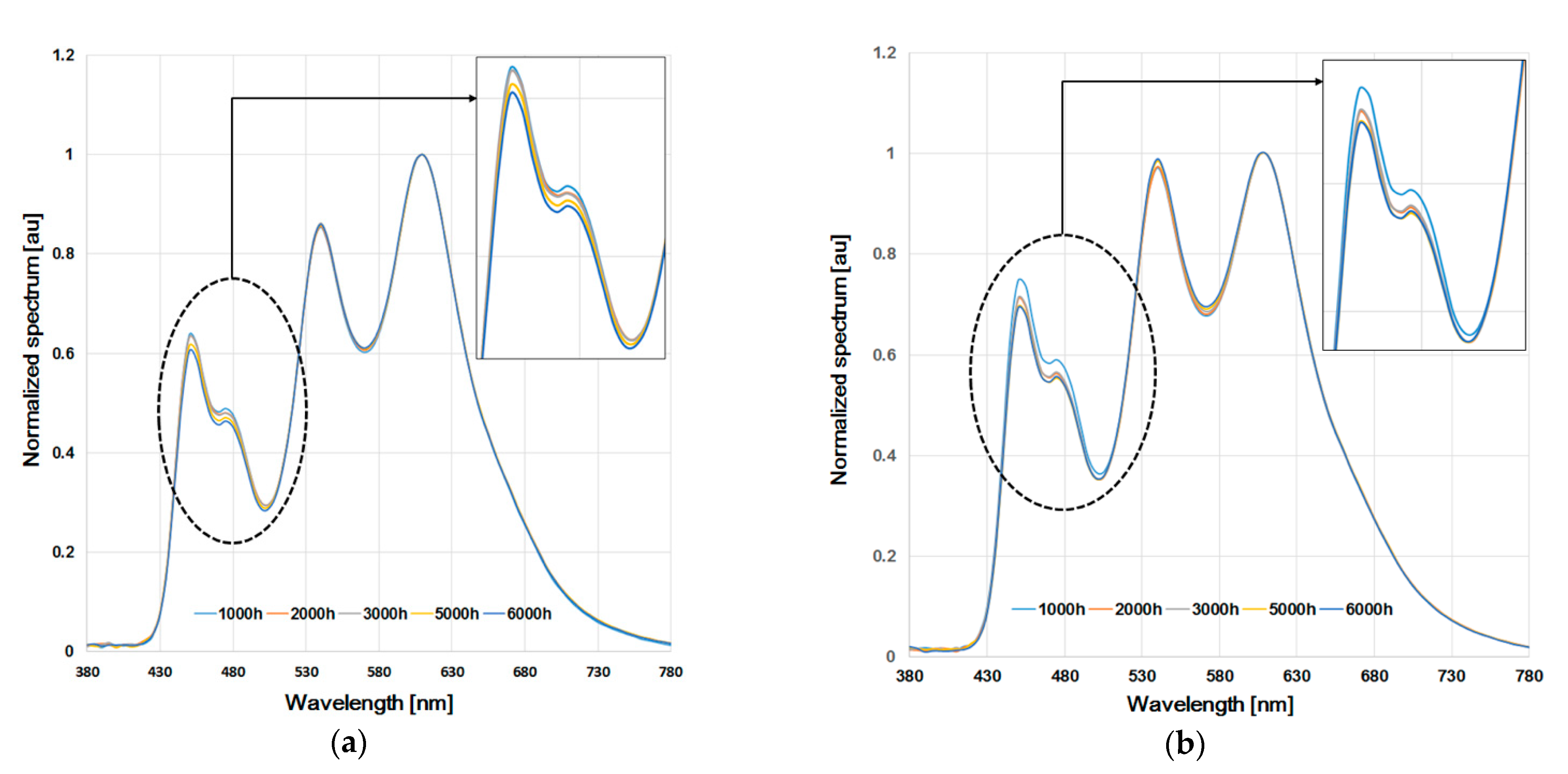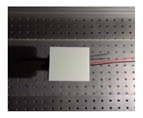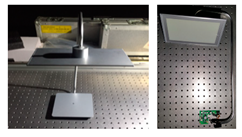3.1. Lumen Maintenance Characteristics of OLED Panels and Luminaires
To investigate the long-term reliability of OLED light panels and luminaires, we have measured the maintained lumen output characteristics. Maintained lumen output of OLED panels and luminaires after six thousand hours to their initial value is shown in
Figure 2a,b, respectively. All OLED panels show about 80% of lumen maintenance and similar degradation characteristics even at six thousand hours of operation. In case of OLED luminaires Type E and F, lumen output degrades more steeply even at two thousand hours compared to OLED panels (type A, B, C, and D). This is because, in case of OLED luminaires, lumen degradation effect got worse by the effect of the control gear which is integrated in the luminaires and the overall luminaire design including thermal management. Moreover, the difference in the degradation pattern of OLED luminaires from one thousand hour to four thousand hour came from each unique design by the different luminaire manufactures.
To evaluate the lumen maintenance of OLED panel and luminaires, lumen output data of three samples in each type were averaged. As the results, the averaged lumen maintenance of each OLED type at six thousand hours aging was evaluated in
Table 3. As shown in
Table 3, lumen outputs of all OLED panels were maintained to 80% after six thousands operation with rated condition. However, in case of OLED luminaires, maintained lumen output was 50% for type E and 40% for type F, respectively. For luminous efficacy, initial values of OLED panels were 50 lm/W for OLED panel type A, B, and C and 40 lm/W for OLED panel type D. After six thousand hours of operation, the luminous efficacy was decreased by amount of 10 lm/W.
International Electrotechnical Commission (IEC) technical committee 34 (title: lighting) has responsibility for safety and performance standard of OLED product for general lighting. Up to date, there is no international standard or industry standard, i.e., de facto standard for lifetime estimation of OLED product for general lighting. However, IEC 62922 (OLED panels for general lighting–Performance requirements) [
17] standard, now in amendment stage, covers lifetime issue of OLED product for general lighting. In this amendment, process for lifetime evaluation is similar to that of LED packages for general lighting applications. To evaluate the lifetime of LED packages, there were many discussions over the couple of years. Then ANSI/IES TM-21: Projecting Long Term Lumen, Photon, and Radiant Flux Maintenance of LED Light Sources standard [
18] and IEC 63013: 2017: LED packages—Long-term luminous and radiant flux maintenance projection standard [
19] were developed and well adopted in the lighting industry.
In these standard, exponential least squares curve-fit method was used with averaged normalized luminous flux data as shown in Equation (1).
where:
t = operating time in hours
= averaged normalized luminous flux output at time t
= projected initial constant derived by the least squares curve-fit
= decay rate constant derived by the least squares curve-fit
The following Equation (2) was used to project lumen maintenance lifetime.
where:
- =
lumen maintenance life expressed in hours where p is the percentage of initial luminous flux that is maintained
- =
total duration time divided by 1000 and rounded to the nearest integer
Above Equations (1) and (2) were used to evaluate the lifetime of OLED panels and luminaires with six thousand hours data, the results are shown in
Table 4. Reported L70(6k) means that a lifetime of OLED product which maintains 70% of its initial luminous flux output, and the reported L70(6k) using extrapolation method in IES TM-21 standard was over ten thousand hours for all type of OLED panels (type A, B, C, and D) and under five thousand hours for OLED luminaires (type E and F). In case of reported L50(6k) means that a lifetime of OLED product which maintains 50% of its initial luminous flux output, and the reported L50(6k) was over twenty thousand hours for all type of OLED panels (type A, B, C, and D) and under six thousand hours for OLED luminaires (type E and F). Alpha parameter and B parameter for all four types of OLED panels have similar values, thus all OLED panels have same degradation mechanism. Actually, these four types of OLED panels were manufactured by same manufacturer and fabrication process, thus their alpha parameter and B parameter are very similar to each other. In case of OLED luminaires, we had same results as shown in
Table 4. Remarkably, flexible OLED panel (type B) show equivalent reliability characteristics to that of rigid OLED panel (type C) which has the same dimensions and operating conditions. Maximum error between the measured lumen degradation data and the predictive model at six thousand hours was about 2% for all cases.
3.2. Color Maintenance Characteristics of OLED Panels and Luminaires
Because humans may perceive the shift of CCT over 100 K at warm color temperature range, the amount of shift in OLED products with operating is one of the critical points of OLED products for general lighting applications. To evaluate maintained CCT characteristics of OLED panel and luminaries, CCT shift data of three samples in each type were averaged as shown in
Figure 3.
The amount of CCT shift was below 100 K with OLED panel type A, B, and C. Only type D OLED panel shows CCT shift over 100 K after six thousand hours as shown in
Figure 3 and
Table 5. Even in this case the difference of each three samples is very small. Thus CCT maintenance characteristics of OLED panels are not inferior to that of LED light sources [
20]. The reason on relative large shift of type D OLED panel is that the type D is the largest OLED panel and operated with high operating current of 800 mA. The surface area of type D OLED panel is bigger than that of other OLED panel type by three times. Thus the total CCT shift was accumulated along the surface area. In case of OLED luminaires, the amount of CCT shift reached to over 100 K during the experiment.
CRI is one of the parameters that provide quality of light for general lighting applications. Maintained CRI characteristics of OLED panels and luminaries after six thousand hours are shown in
Table 6. The initial CRI of all OLED panels are about 90 and the decrease of CRI after six thousand hours within 2 for OLED panels and 3 for OLED luminaires in the experiments.
3.3. Electrical Maintenance Characteristics of OLED Panels and Luminaires
To evaluate the electrical maintenance characteristics of OLED products, operating voltage and power were measured up to six thousand hours while applying constant current to them. Maintained operating voltage required to supply constant current for OLED products tended to rise during long operation because of degradation of OLED products as shown in
Table 7. In case of OLED panels, the increment of operating voltage after six thousand hours was 0.07 V (type A), 0.34 V (type B), 0.29 V (type C), and 0.22 V (type D), respectively. It means that maximum increment of operating voltage for OLED panels is less than 6%. However, for the OLED luminaires, the increment of operating voltage after six thousand hours came to 0.71 V (type E) and 1.01 V (type F). Thus, the maximum increment of operating voltage for OLED luminaires is about 16%. In the IEC 62922 which is performance requirements standard, the manufacturer declares the maintained operating voltage value at two thousand hours, then the operating voltage should not exceed the declared value with operation of two thousand hours. Thus necessity of the dedicated OLED control gear turns out in this study because LED control gear was used generally for OLED panel in the market.


















